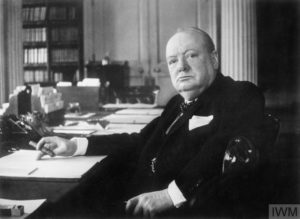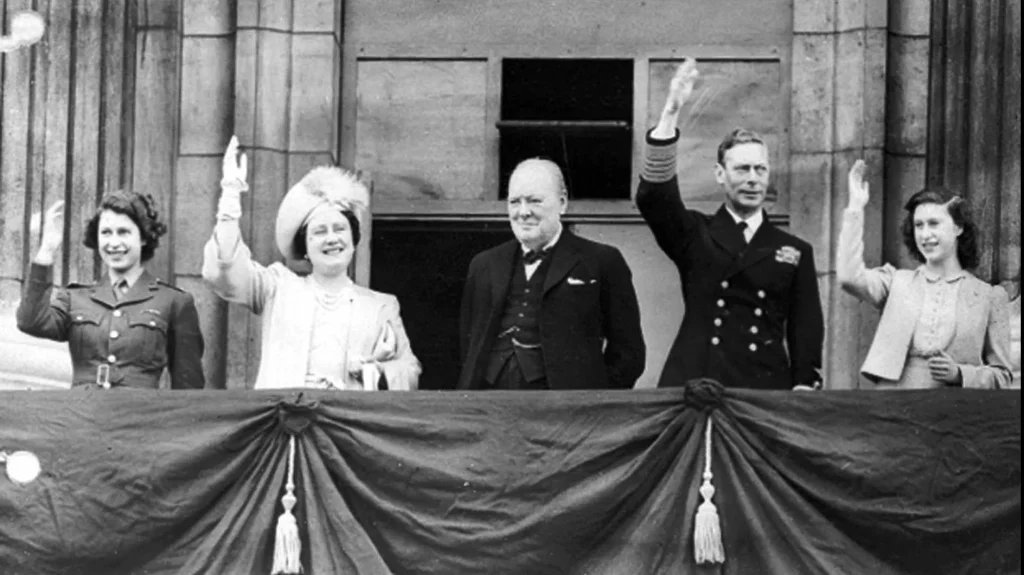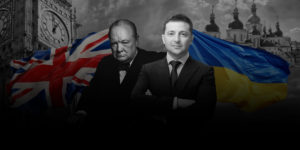
Bulletin #170 — Special 2022
The King Is Not Leaving

July 26, 2022
Ukraine’s First Family Today and Britain’s Royal Family in the Second World War
By HUGO VICKERS
It was a generous gesture from President Biden to offer to extricate President Zelenskyy from Ukraine, but it was no surprise to hear that that most courageous of presidents had no intention of accepting. He knew he had to be with his people: “I don’t need a ride. I need ammunition.” President Zelenskyy has echoed the words of Winston Churchill in his inspiring imprecations to the Ukrainian people and now, possibly unwittingly, he follows the example of another young family who were presented with the same problem back in the last century.
When Britain went to war in September 1939, King George VI had only been on the throne for two and a half years. Queen Elizabeth, who became known as Queen Mother after the King’s death, felt that the years of peace (only twenty years) had in some way been an interlude, and that the Second World War seemed to be almost a continuation of the First. At the outbreak of war, the King and Queen were in London and their daughters were up in Scotland, where they stayed until plans could be made for them. A number of families sent their children over to the USA or Canada. These varied from Crown Princess Juliana of the Netherlands, who was one who took that route, to John Julius Cooper (later Viscount Norwich), son of Duff and Lady Diana Cooper, and to Vivien Leigh’s daughter, Suzanne. She was sent across the Atlantic to Canada with her grandmother.
But Queen Elizabeth saw the need for the Royal Family to set an example to the British people. She declared that her daughters would never leave without her, that she would never leave without the King and that the King himself would certainly never leave. And so they stayed. President Zelenskyy’s wife, Olena, declared something very similar on Instagram: “Today I will not have panic and tears. I will be calm and confident. My children are looking at me. I will be next to them. And next to my husband. And with you.”
President Zelenskyy is 44 years old. King George VI was 45 at the outbreak of war. The King and Queen had the two daughters, Princess Elizabeth (then 13), and Princess Margaret (nine). The Zelenskyys have a seventeen-year-old daughter, Aleksandra, and a six-year-old son, Kiril. Princess Elizabeth and Princess Margaret stayed in Scotland until Christmas 1939. It was then deemed possible to have Christmas at Sandringham, despite Norfolk being exposed on Britain’s exposed east coast. In January 1940 it was announced that the princesses had left for “their new evacuation home in the country.” This was Windsor Castle, though it was not stated as such. Princess Margaret said later: “We left for the weekend and stayed five years.” She also noted that the castle was surrounded by barbed wire: “which wouldn’t have kept the Germans out, but certainly kept us in.”

2024 International Churchill Conference
Queen Elizabeth took shooting lessons at Buckingham Palace, focusing on hapless rats in the garden. She wanted to be prepared for invasion. She made inspirational speeches to the women working in the factories and to others. She and the King made a point of visiting bombed areas in London and elsewhere, walking amongst their people to comfort them. They also gave a weekly lunch to Winston Churchill, who succeeded Neville Chamberlain as Prime Minister in May 1940. Churchill said later that these private lunches were a great help to him in wartime. The King and Queen dispensed with servants at the table, so that they could speak freely, and, since they were frequently traveling around Britain, they were able to tell their Prime Minister the mood of the country. The Queen even copied out an inspirational poem for Churchill, and sent it round to Downing Street.
Princess Elizabeth was only 16 when in October 1940, she broadcast to evacuated children, telling them that when peace came: “it will be for us, the children of to-day, to make the world of to-morrow a better and happier place.” (To this message of eighty years before she referred in her now famous Covid speech from the castle in April 2020). She “dug for victory,” and from time to time the princesses were seen riding bicycles behind their mother’s pony cart, a calmer, happier world for which the British people were fighting. These were important images of peace—the Queen Mother never wore uniform in wartime. She always remained a civilian, her beige and pale coloured outfits in stark contrast to the black boots and uniforms of Nazi Germany.
Princess Elizabeth turned 19 in April 1945 and was old enough to take her own part in the war effort by joining the Auxiliary Territorial Service (ATS). She trained as a driver and as a mechanic, starting as a Second Subaltern and being promoted to Junior Commander, again setting an example—to girls of her age. And then the war ended.
For both President Zelenskyy and the King, the message was the same. They were with their people, and while George VI was in London, however bad the war became, however much the enemy bombs rained down, there was hope. He inspired his people. When the King died in 1952, Churchill’s wreath bore the simple words: “For Valour.”
Hugo Vickers’ books include Elizabeth, The Queen Mother (Hutchinson, 2005).
Subscribe
WANT MORE?
Get the Churchill Bulletin delivered to your inbox once a month.



